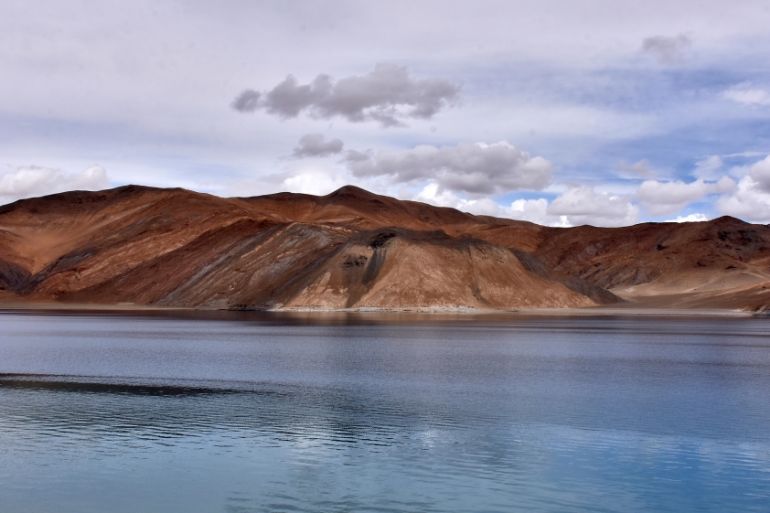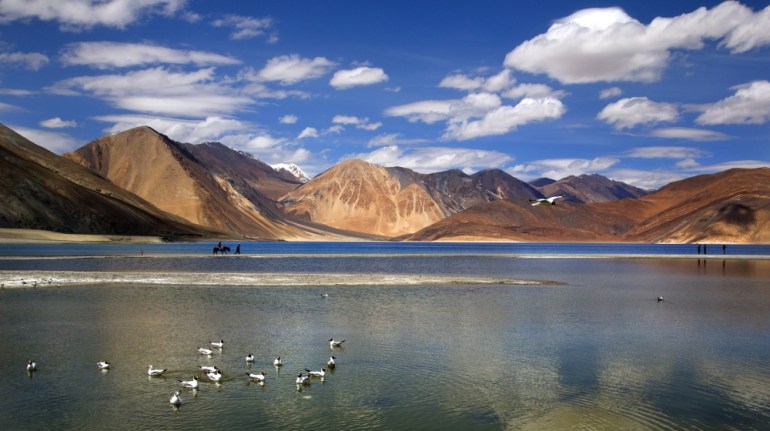India reopens famous Ladakh lake bordering China for tourism
Despite continuing military standoff with China, India’s decision to reopen the lake is welcomed by Ladakh residents.

New Delhi, India – Even as the standoff between Indian and Chinese armies continues in the Himalayan region of Ladakh for eight months now, the local administration’s decision to reopen the Pangong Tso lake for tourism has come as a glimmer of hope for the local residents.
On Sunday, the administration of the newly-created federal territory of Ladakh opened the world’s highest saltwater lake, almost a year after it was closed for tourists due to COVID-19 restrictions followed by the military standoff along the disputed border between the two Asian giants.
Keep reading
list of 4 itemsIndia says China ties ‘profoundly disturbed’, on upswing with US
Ladakh Buddhists who hailed India’s Kashmir move not so sure now
How Indian and Chinese media reported the deadly Ladakh clash
Both sides accuse each other of intruding across the loosely-demarcated de facto border, known as the Line of Actual Control (LAC), with Pangong Tso, located 14,000 feet (4,270 metres) above sea level in Ladakh, being one of the flashpoints.
The standoff began in May last year after a scuffle broke out between Indian and Chinese troops at the lake, resulting in 11 soldiers being injured on both sides. A video shot by an Indian soldier and shared on social media showed soldiers from both nations engaged in fistfights and stone-pelting at the LAC.
The military standoff intensified a month later when 20 Indian soldiers and an undisclosed number of Chinese troops were killed in hand-to-hand combat on June 15, 2020 – the worst clashes between the two forces in decades.

The LAC dividing the two nuclear-armed nations passes through the landlocked 135km (84 miles) long, boomerang-shaped lake, which is 6km (3.7 miles) wide at its broadest point. One-third of the lake falls under the Indian territory while the remaining area is under Chinese control.
The western end of Pangong Tso lies 54km (33 miles) southeast of Leh, the main city in Ladakh region.
Welcome move, say locals
“The majestic Pangong Lake has been reopened for tourists starting January 10. So, get inner line permit (ILP) and visit this spellbinding lake,” the local administration said in its announcement on Sunday.
The move has revived hopes among the locals of a good upcoming tourism season in the Himalayan region.
“It’s a really good news because the Pangong Lake is one of the most visited places for tourists in Ladakh. It will definitely help the local tourism industry,” Konchak Stanzin, an elected councillor from the region, told Al Jazeera.
Stanzin, who represents Ladakh’s Chushul constituency where the Pangong Lake is located, said 60 percent of Leh’s population depends on tourism. He invited the tourists to visit the frozen lake before winter ends.
Though tourism was hit globally due to the coronavirus pandemic, its impact was felt harder in Ladakh where tourism season is squeezed to just a few months, mostly from April to mid-October, due to the freezing winters in the region.
Delex Namgyal, a travel and tour operator in Leh, told Al Jazeera over the telephone that the timing of the reopening of the lake for tourists could not have been better since January and February are the months when bookings for the summer season begin.
“The timing is good. It will give a positive message that Ladakh is opening up for tourists,” said Namgyal, adding that almost 80 percent of Indian tourists arriving in Leh visit the lake.
While just a few thousand tourists visit Ladakh during winters, Namgyal said that number can go up to more than 250,000 during summers.
Tsewang Yangjor, a hotelier in Leh, told Al Jazeera 2020 was a “disastrous year” for the local tourism industry and they are “happy that things are improving and the lake has been opened for the tourists”.
“I think the situation [along China border] might be normal now and that is why they have decided to give permit [to visit the lake],” he said.
India-China tensions
But the situation along the LAC is far from normal, with both sides deploying a large number of troops along the Himalayan frontier. Several rounds of military and diplomatic talks between the two nations have failed to end the standoff.
The decision to reopen the Pangong Tso lake came a day before India handed back a Chinese soldier apprehended along the southern bank of the lake after he transgressed into the Indian side.
India’s Foreign Minister Subrahmanyam Jaishankar on Tuesday said relations with China have been “profoundly disturbed” after last year’s deadly border clash.
China and India fought a war in 1962 and continue to be engaged in several disputes along the 3,488km-long (2,167 miles) frontier they share. Yet, the two countries have remained focused on expanding commercial relationships despite the tensions.
Though happy with the Ladakh administration’s decision to reopen the lake situated along the tense India-China border, tour operator Namgyal has a word of caution: “The standoff can still have a negative impact [on tourism] if the situation worsens.”